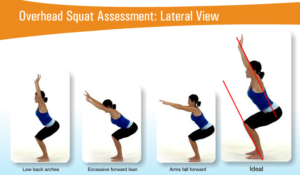When done properly the squat is a safe and effective exercise that can be used for strengthening your entire body. Performing a correct squat requires the upper and lower body to work in unison, activating an estimated 200 muscles or more.

To make sure that your squats will reward your efforts with amazing gains, and not injury (“no pain, no gain” does not apply here), it’s important to make sure your technique is on point. A good way of starting out is to perform a Squat Assessment, to gain information about the areas you are lacking, from head to toe.
Of course, it’s difficult to observe yourself performing squats, even in front of a mirror, so consider enlisting the help of a friend, or you could film yourself so that you can get an objective view of areas where you may need to improve.
How to perform a squat assessment
- Wear shorts and a t-shirt, to make it easier to observe your movements and identify faulty movement patterns.
- Film yourself (or have your friend watch you) from the front and side view, to get a complete overview of your squat technique
- Stand with the inside of your feet aligned with the outside of your shoulders
- Feet should be facing straight ahead. Arms should be extended above the head.
- Lower yourself down as far as comfortable, taking around 2-3 seconds to do so
- Return to the starting position
- Keep your heels on the ground, throughout the whole movement
So, what are you looking for? Here’s a checklist of things you need to pay attention to:
Starting Position Key Points:
- Arms extended above head
- Feet shoulder width apart
- Feet pointing straight ahead
- Eyes fixed straight ahead
Finish Position Key Points:
- Arms stay straight
- Don’t lean forward too much
- Feet stay pointing straight
- Heels stay on ground
- Knees stay in line with feet
Problems to watch for:
- Knees buckling inwards
- Arms bending at the elbow or swaying excessively forward
- Heels lifting off the floor
- Upper body and shoulders leaning forward excessively
- Lower back loses neutral spine position (twists or bends)
By working through the above checklist, you will be able to identify basic movement faults before they potentially become a problem.
Next Steps
If your Squat Assessment has highlighted areas that you need to improve on, you must check out our blog post, The 6 Golden Rules for achieving the perfect squat. This will give you, in detail, a step-by-step guide to achieving flawless squats.


